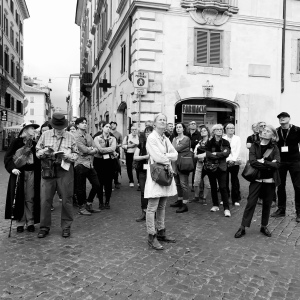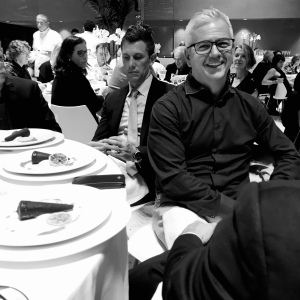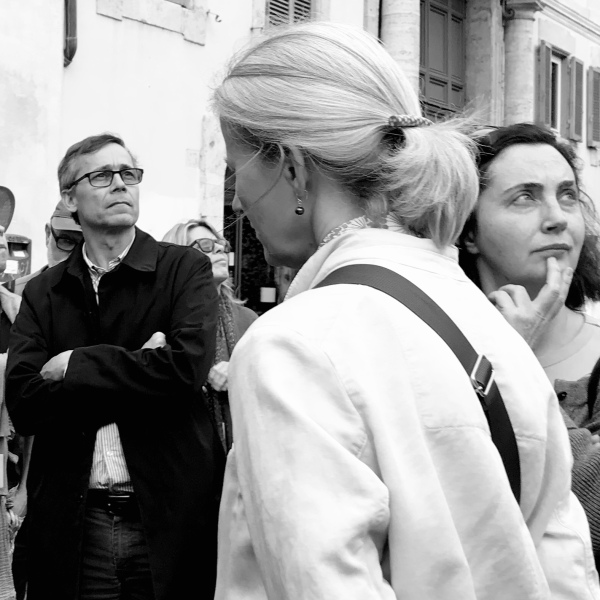No, this blog post is not about an “extra-large” version of ROME, but rather it documents, in black and white, the celebration of the 40th anniversary of the University of Waterloo, School of Architecture, Rome Program, held between October 30th and November 2nd, 2019. I don’t remember this photo being taken of me. I was actually listening to Eric’s lecture about the history of the Pantheon.
I don’t remember this photo being taken of me. I was actually listening to Eric’s lecture about the history of the Pantheon.
Established in 1979, the program was on the leading edge of architectural education in North America. As Larry Richards, Director of the Waterloo School of Architecture (1982-1987), writes in the recently published book, “Canadian Modern Architecture, 1967 to the present.” in his chapter on Postmodernism : Reconnecting with History, Memory and Place,
In the 1960’s, a reaction to modern architecture and its limitations emerged in Canada, Europe and the United States. Modernism’s post-World War II emphasis on abstraction, technologically driven rationality, avoidance of ornament, and disregard for history became suspect. Architects began to consider how deeper connections might be made with specific histories and contexts to create distinctive, human-centered places. Embracing relativism, pluralism, hybridity, and popular culture, a bold critique of modernism gained momentum, reflecting the heterarchical nature of a radically changed world.
It is within this historical context that the program was established, thus exposing students in their travel to Rome, to the layers of human history that exist throughout Italy.
Prof. Eric Haldenby, Director of the Waterloo School of Architecture (1988 – 2013), was instrumental in the establishment of the Waterloo Rome Program, and has had a significant role in the education of those who have traveled to Italy over the past 40 years. His passion for and expertise of Roman history, which developed and evolved through his lifetime and academic career, are common threads that link the four decades of the program.
 Eric Haldenby leading a tour of the Forum and Palatine Hill.
Eric Haldenby leading a tour of the Forum and Palatine Hill. Eric Haldenby points to the Pantheon as alumni gathered around him in the Piazza della Rotonda.
Eric Haldenby points to the Pantheon as alumni gathered around him in the Piazza della Rotonda.Lorenzo Pignatti, who joined the academic team in 1981, imparted a uniquely Italian approach to understanding the city in all its complexity. Together, they brought in talent from the faculty and alumni of the Waterloo School of Architecture, as well as inviting guests from around the world to participate in the program; thus, providing each group of students a unique perspective on studying abroad.
 Lorenzo Pignatti in front of Michelangelo’s Capitoline Hill
Lorenzo Pignatti in front of Michelangelo’s Capitoline Hill Lorenzo Pignatti at the Palazzo Farnese with at group of alumni.
Lorenzo Pignatti at the Palazzo Farnese with at group of alumni.For me personally, what was especially wonderful about the reunion experience was observing other alumni who had attended classes throughout many years prior – gathered around Eric and Lorenzo, and listening intently with a new perspective and a lifetime of experience behind them. Each of us had the opportunity to recall, in our own way – how our time immersed in the culture and heritage of Rome influenced the way we see the world.
 Lorenzo describing the evolution of the Piazza d el Campidoglio
Lorenzo describing the evolution of the Piazza d el Campidoglio Lorenzo Pignatti on the Campus Martius Tour
Lorenzo Pignatti on the Campus Martius Tour Alumni on the Campus Martius Tour
Alumni on the Campus Martius Tour Eric Haldenby surrounded by alumni of the past four decades.
Eric Haldenby surrounded by alumni of the past four decades.I knew when I was attending the Rome Program that it was contributing to an extraordinary educational experience. The four day reunion in the fall of 2019, some thirty one years later, made it abundantly clear to me that I had participated in a very special phenomenon.
 National Gallery of Modern Art
National Gallery of Modern Art Piazza Navona
Piazza Navona The Turtle Fountain on the Tour of Campus Martius
The Turtle Fountain on the Tour of Campus Martius Many by-standers stopped to listen to Lorenzo as he was describing the Palazzo Farnese.
Many by-standers stopped to listen to Lorenzo as he was describing the Palazzo Farnese. Alumni evening concert at the Auditorium Parco Della Musica by Renzo Piano.
Alumni evening concert at the Auditorium Parco Della Musica by Renzo Piano. Grand staircase at the MAXI, designed by Pritzker Prize winner, Zaha Hadid. The location of the ROME XL Symposium.
Grand staircase at the MAXI, designed by Pritzker Prize winner, Zaha Hadid. The location of the ROME XL Symposium.Guests at the Gala Dinner were welcomed by Dr. Anne Bordeleau, The current O’Donovan Director of the University of Waterloo , School of Architecture. Dr. Bordeleau noted that while the context for the establishment of the program has evolved, there are new issues that have risen to the forefront of architectural education. These issues include addressing the climate crisis, and the challenge of housing an ever expanding urban population, among many others. Reflecting on her closing remarks, I feel strongly about the value of placing oneself in the stimulating environment of Rome which can only help to inspire the next generation of students to take on these contemporary challenges, learning from the past to imagine a better future.
 Catalogue from ROMA XL
Catalogue from ROMA XL Kyle Winters who joined me in Rome in 1988 returned for the Rome reunion.
Kyle Winters who joined me in Rome in 1988 returned for the Rome reunion. Rosemary Aicher (beyond), Eric Haldenby’s partner, during the gala dinner.
Rosemary Aicher (beyond), Eric Haldenby’s partner, during the gala dinner.The Rome XL reunion was a remarkable milestone in the history of the University of Waterloo, School of Architecture. I know from my own experience that it was truly an inspirational event.






